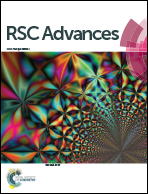Complete recovery of Eu from BaMgAl10O17:Eu2+ by alkaline fusion and its mechanism
Abstract
An environmentally friendly and efficient process for recycling waste phosphors has been developed. The alkaline fusion process is used for recycling Eu from BaMgAl10O17:Eu2+ (BMA) completely. The comprehensive BMA disintegration via alkaline fusion is discussed. Relationships between the alkaline fusion temperature and various properties of the compounds have been examined by various techniques (DSC-TG, XRD, SEM and XPS) to elucidate their roles in BMA disintegration in the alkaline fusion process. X-ray diffraction analysis provides details of the phase change. Based on X-ray photoelectron spectroscopy, a scientific hypothesis of crystal structure disintegration is presented. Sodium ions would substitute the europium and barium ions in the mirror plane and magnesium ions in the spinel block successively, which results in more oxygen vacancies and interstitial sodium ions appearing. The unit cell (P63/mmc (194)) would break from the mirror plane, then changes into BaAl2O4 (P6322 (182)), and be decomposed into NaAlO2, and barium and europium ions combine with free OH− and CO2 to form BaCO3, Eu2O3 and H2O. In the end the Eu2O3 can be recycled easily by acidolysis, oxalic acid precipitation and ignition. The mechanism provides a fundamental basis for recycling REEs from waste phosphors.


 Please wait while we load your content...
Please wait while we load your content...